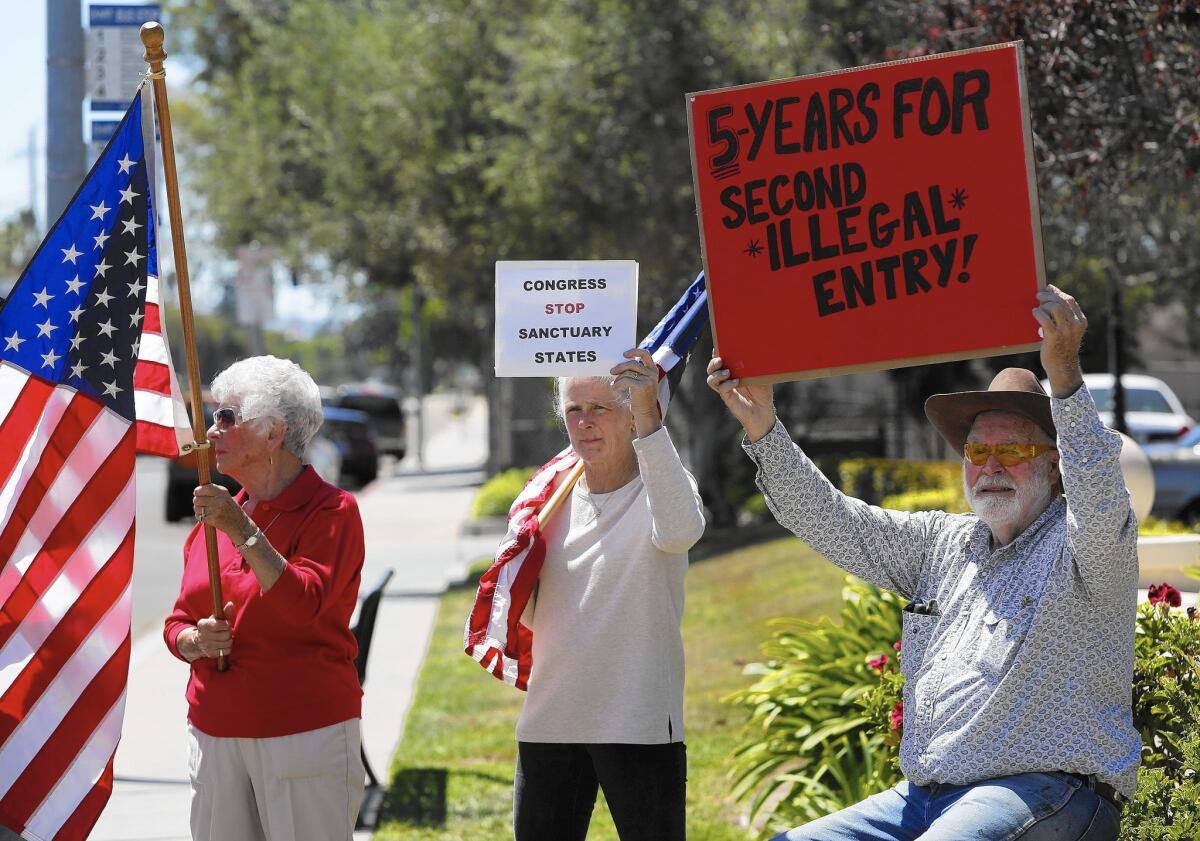Killing in Santa Maria becomes flashpoint in debate on illegal immigration

Protestors wanting illegal immigrants deported demonstrate near the Santa Maria Courthouse on Aug. 13.
reporting from Santa Maria, Calif. â Inice Edwards was one of two dozen protesters standing outside the courthouse here last week when Victor Aureliano Martinez Ramirez appeared to face charges that he raped, tortured and killed a Santa Barbara County woman.
Ramirez, 29, was living in the country illegally at the time of the July 24 attack and was arrested several times in recent years for a variety of offenses. He was released from jail days before police say he and another man broke into the home of 64-year-old Marilyn Pharis and attacked her with a hammer and sexually assaulted her.
Pharis died Aug. 1 from her injuries.
âI donât understand why illegals have all these rights,â Edwards, 78, a Santa Maria resident said. âHe should never have had a chance to do what he did.â
Standing across the street were two dozen counter protesters, including Arnulfo Romero, 55, also a resident of this agricultural and mostly Latino city of 100,000. Romero, a furniture store owner, has lived in Santa Maria since 1969 when he came to the U.S. as a legal resident from Zacatecas, Mexico.
He agreed with protesters that Ramirez should have been deported. But he said the killing, along with a San Francisco case, was being used by politicians and pundits to indict all Latino immigrants in the U.S.
âWhen white people kill each other they say itâs because of mental issues,â he said. âThen they use these cases to go against any and all Latinos here.â
The Ramirez case has served as yet another flashpoint in the national debate on illegal immigration. Many have compared it to the case of Juan Francisco Lopez-Sanchez, a Mexican immigrant who was charged with the fatal shooting of Kathryn Steinle, 32, on Pier 14 in San Francisco on July 1.
Lopez-Sanchez had been deported five times and had seven felonies on his record.
Pharisâ brutal assault also became national news and has stirred emotions among residents of Santa Maria, a city better known for its style of tri-tip and sprawling strawberry fields than for violent crime.
Latinos make up 70% of the cityâs residents â a huge leap from 1990 when the group made up 45% of the population. Whites account for 20% of residents.
The growing numbers of Latinos are making themselves known in city politics.
The demographic shift has resulted in more Latino activism. Thousands took to the streets last year to protest a proposal to build a processing center for convicted criminals who are in the country illegally.
A divided City Council approved the center in a 3-2 vote, but the large protests signaled the arrival of Latinos, said Hazel Davalos, head of the Santa Maria chapter of Coastal Alliance United for a Sustainable Economy, or CAUSE, an organization that helps working families in the region.
Ramirezâs case, the resulting protests and counter protests are part of a complex drama playing out in Santa Maria â the largest city in Santa Barbara County and no longer the conservative bastion it once was.
âIn years past you would have seen the tea party and seen anti-immigrant protesters get away with blaming this on immigrants and no one would speak against that or speak counter to that,â Davalos said. âMexicans and Latinos are defending themselves whereas before we might not have.â
Despite the Ramirez and Lopez-Sanchez cases, national studies have found no link between the numbers of people living in the country illegally and the amount of violent crime in any given area.
In recent years, many cities in Southern California, including Los Angeles, and around the country have experienced some of their lowest levels of violent crime, including homicides, in recent decades even as the number of people in the U.S. illegally climbed to an estimated 11 million.
Last year, a study by Jörg Spenkuch, a professor of economics at Northwestern Universityâs Kellogg School of Management, compared 20 years of national FBI crime statistics with records listing the percentage of immigrants in every county in the continental U.S.
âThereâs essentially no correlation between immigrants and violent crime,â he said in a summary of his study, noting immigrants tend to live in poor areas prone to crime. âSo thereâs this anecdotal association that just doesnât turn out to be true in the data.â
In the Ramirez case, the U.S. Immigration and Customs Enforcement had asked Santa Barbara County custody officials to put a detention hold on the Mexican immigrant last year after he was charged with felony assault with intent to commit sexual assault. The detainer was meant to ensure Ramirez would be transferred into federal custody before his release.
But prosecutors eventually downgraded the charges to a misdemeanor. Santa Barbara County custody officials concluded that keeping Ramirez would violate the stateâs Trust Act, which allows local law enforcement to hold inmates for immigration authorities only if they have been charged with a serious crime.
On July 17, just days before Pharisâ was attacked, Ramirez was booked into Santa Barbara County Jail on drug and weapons charges, according to the sheriffâs office. He was ordered released July 20 after pleading no contest to the weapons charge.
A second man, 20-year-old Jose Fernando Villagomez â who is a U.S. citizen â has also been charged in connection with Pharisâ death.
At a news conference on Aug. 7, Santa Maria Police Chief Ralph Martin denounced state and federal detention policies for immigrants living in the U.S. illegally, saying âthereâs a blood trail leading to the bedroom of Marilyn Pharisâ from Sacramento and Washington.
Mayor Alice Patino said Santa Barbara County law enforcement officials will discuss how Ramirez came to be released at a September Board of Supervisors meeting in Santa Maria.
âWe need to find out how this guy fell through the cracks,â she said. âThere are different issues going on here. This was violence against a woman, there are immigration issues of course, the crime issue is always there. It is a tragedy.â
Women from the North County Rape Crisis and Protection Center plan to hold a vigil for Pharis at 7 p.m. Friday in front of Santa Maria City Hall.
Times staff writers Ryan Menezes and Brittny Mejia contributed to this report.
ALSO:
San Francisco homicide suspect was deported five times
Trump plan: Make immigrants pay for âpermanent border wallâ and deport millions
Spurned by local law enforcement, ICE stages elaborate immigration raids
More to Read
Sign up for Essential California
The most important California stories and recommendations in your inbox every morning.
You may occasionally receive promotional content from the Los Angeles Times.











